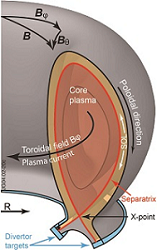ScrapeOff Layer and Divertor Physics
Contact Persons: Bruce Lipschultz, Ben Dudson and Istvan Cziegler

The current most advanced form of a magnetic fusion reactor is the tokamak, the topology of which is shown. Magnetic fields confine the core plasma where the fusion reactions occur and where 20% of the reaction output power is absorbed, sustaining the high densities and temperatures and fusion reactions. In steady state, energy/power leaks across the separatrix into the ScrapeOff Layer (SOL) and flows in a very narrow (Predicted to be ~ 1 mm thick) heat flux channel; that heat flow corresponds to high power densities of order 10s of GW/m^2 in a reactor, much too high for surfaces to survive in steady state.
Optimizing the atomic and transport properties of the SOL and divertor plasmas to remove power from that channel and spread it over much larger areas is essentially the last hurdle to be overcome on the path to Fusion energy.
Furthermore, there is evidence that the SOL properties affect the properties of the core plasma (boundary conditions of density, temperature, and impurity levels). Ultimately, the SOL and divertor offer a route to further optimisation of the fusion power output.
Our research includes both modelling and experimental research into the underlying physics processes and control of the plasma properties in both the SOL and divertor regions.
